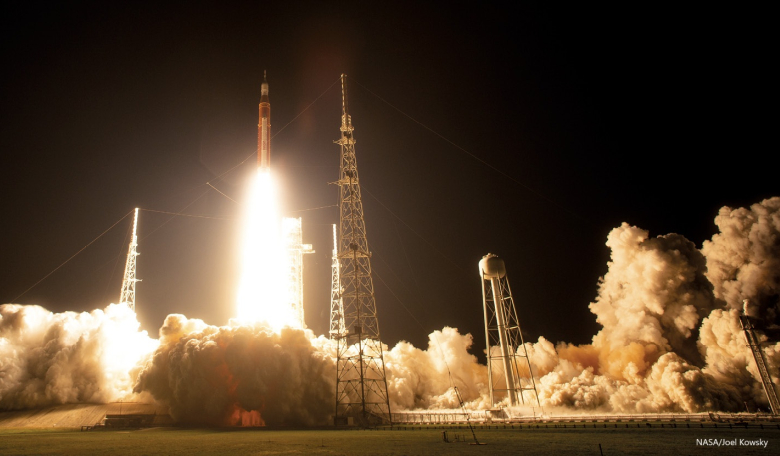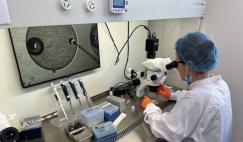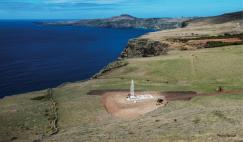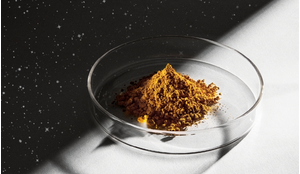In recent years, Lego has produced a number of large, space-related construction kits for adults. In this article, Mark Williamson reviews its latest rocket kit – for the Space Launch System (SLS) - and sets the iconic plastic bricks in the context of the real-world Artemis programme.
Much has changed at Florida’s launch sites since the halcyon days of the Moon launches and NASA is no longer the only game in town. The Apollo programme was fast-paced to meet Kennedy’s lunar challenge, but the launch pads reverberated to the sound of a Saturn launch only a few times per year. Today, Florida sees a SpaceX Falcon launch most weeks of the year, and sometimes twice in the same week!
So where is NASA in this hubbub of rocketry? Preparing for a return of astronauts to the Moon and, perhaps in the longer term, a crewed mission to Mars. The NASA programme dedicated to this task is called Artemis, after Apollo’s twin sister in Greek mythology, and its launch vehicle is the less-imaginatively named Space Launch System (SLS). So far, the SLS has conducted a single launch, for the Artemis I mission, which placed an uncrewed Orion spacecraft on a 25-day loop around the Moon in November 2022.
The effort required to complete such a model is significant: fitting 3600 separate pieces together (in the correct configuration) is not an evening’s work
The Artemis-SLS programme, formally announced in April 2019, had predicted an Artemis II mission by 2022, but this was later delayed until 2025. NASA’s current expectation is to launch Artemis II, which will take a crew of four on a 10-day lunar fly-by, in April 2026. So the US space agency is not exactly drumming a driving beat!
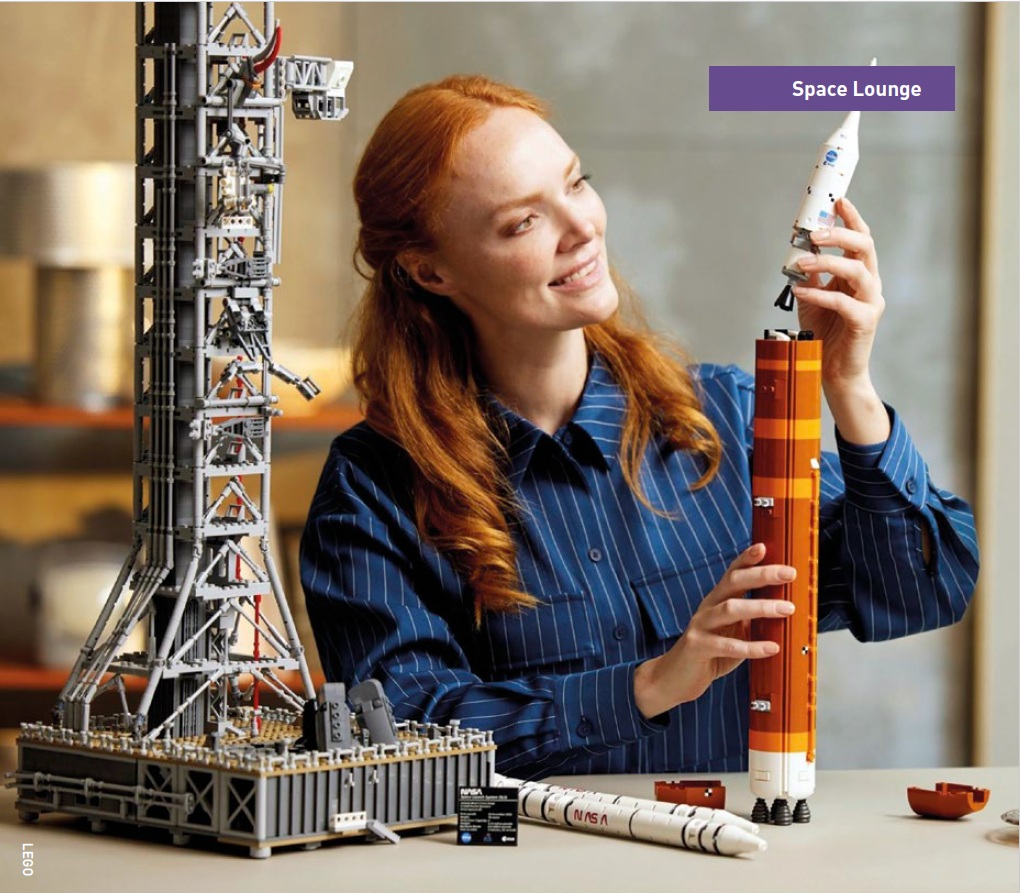 The Lego SLS model can be removed from the pad, the boosters can be separated and the Orion capsule removed from the fairing.
The Lego SLS model can be removed from the pad, the boosters can be separated and the Orion capsule removed from the fairing.
Given this context, it is somewhat surprising – though admittedly welcome – that the famous plastic brick manufacturer LEGO Group has released an impressive construction kit of the SLS on its mobile launch platform.
Lego rocket
The ‘NASA Artemis Space Launch System model building kit’, to give it its official Lego title, has 3600 pieces and produces a decent facsimile of the system (70 cm high on a 27 x 30 cm base). The vehicle itself can be removed from the pad, the strap-on solid rocket boosters (SRBs) can be separated and the Orion capsule removed from the fairing. On the tower, the white room and umbilicals can be rotated in and out of position and parts of the launch platform sidings have been removed to allow views of the interior.
According to Lego model designer Hans Burkhard Schlomer, “A little bit of Lego rocket science was required… to have different functional stages of the rocket. Just like in real life, a vehicle safety system secures the rocket to the launch tower, and retractable service umbilicals can be disengaged prior to launch”.
So far, the SLS has conducted a single launch, for the Artemis I mission, which placed an uncrewed Orion spacecraft on a 25-day loop around the Moon in November 2022
Certainly, from a distance, one gets the impression of a fairly accurate scale model. This is achieved in part by the orange and brown colours of the stage insulation and also by the markings on the SRBs. However, Lego’s choice of which markings to print on the model and which to include on a sticker sheet is a strange one; in fact, some of the stickers are so small and difficult to apply that one feels it would have been better to pre-print them all.
Overall, the effort required to complete such a model is significant: fitting 3600 separate pieces together (in the correct configuration) is not an evening’s work - unless of course you are a ‘champion Legoist’. The plethora of plastic mouldings is carefully selected and delivered in 27 main (and multiple subsidiary) plastic bags, the great majority of which build the launch pad and tower, with just six for the SLS itself.
This reviewer spent many highly-focused hours in building this model. Having constructed Lego’s excellent Saturn V and Space Shuttle offerings, I can claim a degree of proficiency, but I have to admit that building the Artemis launch tower was not the most interesting use of my time – highly repetitive does not quite cover it! Lego publicity blurb pitches this as a “mindful building experience”, but perhaps that refers more to the level of concentration required than achieving a state of nirvana.
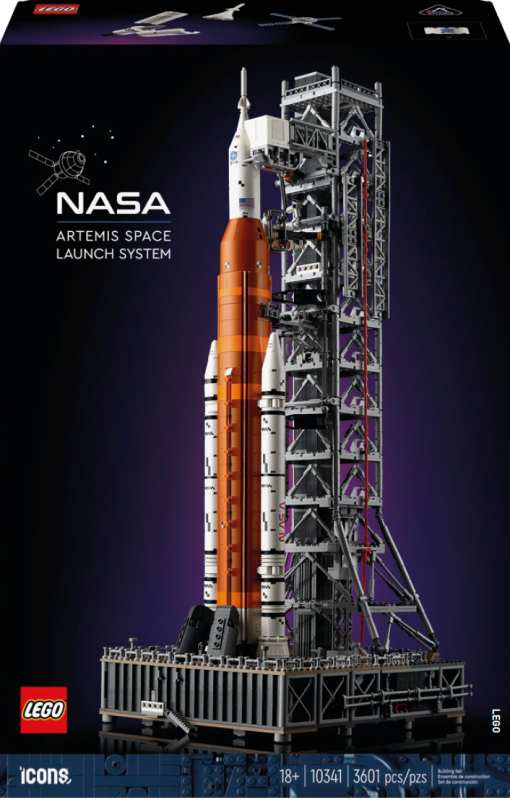 LEGO’s ‘NASA Artemis Space Launch System’ model building kit has 3600 pieces in 27 separate bags and comes with a 370-page instruction booklet.
LEGO’s ‘NASA Artemis Space Launch System’ model building kit has 3600 pieces in 27 separate bags and comes with a 370-page instruction booklet.
One aspect of these kits I am always amazed at – and thankful for – is the hard copy instruction booklet that accompanies each set. The one for the Artemis has no less than 370 pages, depicting (in colour) the 27 construction stages, piece by piece; honestly, the compilation of this booklet is as significant a task as moulding the model pieces!
The price of these major kits is a bit eye-watering in comparison with other consumer products (to use a very broad term), but when you consider the amount of time, effort and salaries that goes into them one can understand it. As for the purchasing decision, Lego publicity suggests that you “treat yourself” (which seems fair)… or consider it an “any-day gift for your favourite space enthusiast” (which begs far too many questions on the subject of gifting!).
Return to the (real) Moon
NASA’s current plans have Artemis III launching in mid-2027, when it hopes to deliver two astronauts to the Moon’s south pole
One thing Lego has got right, as far as could reasonably be expected, is the timing for the release of its Artemis model. The SLS is not a proposed launch vehicle – it has actually flown – and the delays to its second mission mean that the Lego version will remain current at least until 2026. After that, on-one really knows.
NASA’s current plans have Artemis III launching in mid-2027, when it hopes to deliver two astronauts to the Moon’s south pole. If this date is met – which recent history suggests is unlikely – the mission would mark the first landing of humans on the lunar surface in 55 years. The last Apollo mission (Apollo 17) was in December 1972 - so long ago that today’s kids consider it ancient history.
Unfortunately, this is where politics rears its ugly head, as it so often does with proposed space missions, and the jury is still out concerning what US President Trump will do to NASA’s plans, especially as he will have Elon Musk whispering in his ear.
The space rumour mill suggests the writing is on the wall for the SLS, partly because of its glacially slow development but mainly because of its high cost (estimated at more than $2bn per launch!). The question, of course, is what would replace it: NASA officials have been quoted as saying the SLS is “the only rocket that can send Orion, astronauts and cargo directly to the Moon in a single launch”.
Some commentators have suggested that the SpaceX Falcon Heavy launch vehicle could replace the SLS, but this seems unlikely because of the adaptations and additional qualification required. Rocketry for manned spaceflight is far from ‘plug-and-play’ and safety considerations mean that SLS and Orion are almost as closely linked as the venerable Saturn V was to Apollo.
Any discussion about manned lunar exploration has to factor-in China, which is understood to be planning to send astronauts to the lunar south pole around 2030Photo:
Moreover, any discussion about manned lunar exploration has to factor in China, which is understood to be planning to send astronauts to the lunar south pole around 2030, a favoured destination because of the likelihood of finding water-ice there. NASA officials are adamant that no new ‘Moon race’ exists, but that’s like telling the media that politicians are incorruptible. It is arguably more important to ask what President Trump thinks.
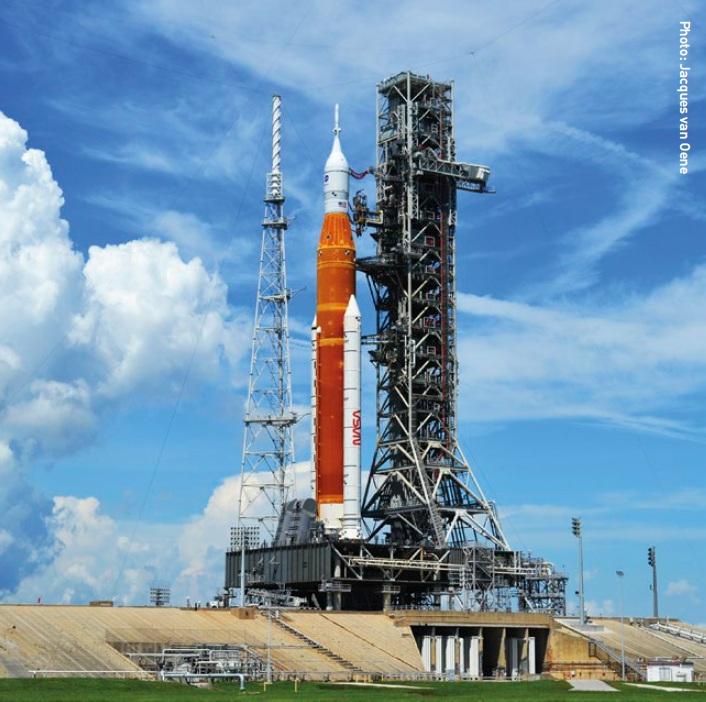 SLS and Artemis on the launch pad at KSC in 2022.
SLS and Artemis on the launch pad at KSC in 2022.
Irrespective of opinions on the matter, Elon Musk’s Starship is already a part of the Artemis programme in providing the ‘Lunar Module’ function - a spacecraft that will transport Artemis III astronauts from the Orion capsule in lunar orbit to the surface of the Moon and back again. However, Starship itself is still in the development phase and Mr Musk is a serial optimist when it comes to project timelines.
Perhaps LEGO should hedge its bets and bring out a model version of the Starship and its Super Heavy booster. Now that would be a construction task to challenge “your favourite space enthusiast”!
Note on pricing
Prices depend on regional markets and suppliers, but Lego’s recommended retail price (RRP) for the NASA Artemis Space Launch System model is £219.99 in the UK, $259.99 in the US and €259.99 throughout the Eurozone.
Editor’s note
ROOM published an article by Mark Williamson on ‘Lego’s replica space programme’ in Issue 24, Summer 2020.
About the author
Mark Williamson is an independent Space Technology Consultant and writer, and a Commissioning Editor for ROOM Space Journal. He has 40 years of experience as a satellite communications engineer and consultant to the space industry, space insurance and space education sectors. He is the author of six books, including The Cambridge Dictionary of Space Technology and Space: The Fragile Frontier, has edited three space industry magazines and written more than 600 articles and papers on space technology. He has a BSc in physics and astrophysics from Queen Mary London and a PhD in sustainable development of the space environment, and is a chartered physicist and chartered engineer. In 2008, Mark developed a sub-career as a stock photographer and currently licenses images across several platforms including Getty Images and Science Photo Library.





